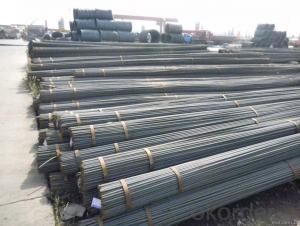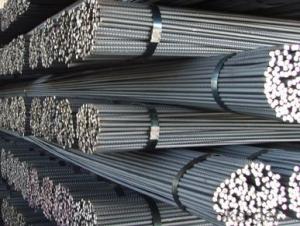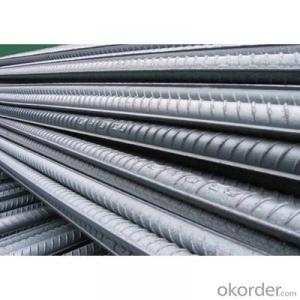ASTM GR60 deformed steel bar for construction
- Loading Port:
- Tianjin
- Payment Terms:
- TT or LC
- Min Order Qty:
- 25 m.t.
- Supply Capability:
- 100000 m.t./month
OKorder Service Pledge
OKorder Financial Service
You Might Also Like
Product Description:
OKorder is offering ASTM GR60 deformed steel bar for construction at great prices with worldwide shipping. Our supplier is a world-class manufacturer of steel, with our products utilized the world over. OKorder annually supplies products to European, North American and Asian markets. We provide quotations within 24 hours of receiving an inquiry and guarantee competitive prices.
Product Applications:
ASTM GR60 deformed steel bar are ideal for structural applications and are widely used in the construction of buildings and bridges, and the manufacturing, petrochemical, and transportation industries.
Product Advantages:
OKorder's deformed steel bar are durable, strong, and resist corrosion.
Main Product Features:
· Premium quality
· Prompt delivery & seaworthy packing (30 days after receiving deposit)
· Corrosion resistance
· Can be recycled and reused
· Mill test certification
· Professional Service
· Competitive pricing
Product Specifications:
| Minimum Order Quantity: | Unit: | m.t. | Loading Port: | ||
| Supply Ability: | Payment Terms: | Package: | wire rod packing |
Product Description:
Product Description:
Chemical Composition: (Please kindly find our chemistry of our material based on HRB500 as below for your information)
Grade | Technical data of the original chemical composition (%) | ||||||
C | Mn | Si | S | P | V | ||
HRB400 | ≤0.25 | ≤1.60 | ≤0.80 | ≤0.045 | ≤0.045 | 0.04-0.12 | |
Physical capability | |||||||
Yield Strength (N/cm²) | Tensile Strength (N/cm²) | Elongation (%) | |||||
≥400 | ≥570 | ≥14 | |||||
Theoretical weight and section area of each diameter as below for your information:
Diameter(mm) | Section area (mm²) | Mass(kg/m) | Weight of 12m bar(kg) |
6 | 28.27 | 0.222 | 2.664 |
8 | 50.27 | 0.395 | 4.74 |
10 | 78.54 | 0.617 | 7.404 |
12 | 113.1 | 0.888 | 10.656 |
14 | 153.9 | 1.21 | 14.52 |
16 | 201.1 | 1.58 | 18.96 |
18 | 254.5 | 2.00 | 24 |
20 | 314.2 | 2.47 | 29.64 |
22 | 380.1 | 2.98 | 35.76 |
25 | 490.9 | 3.85 | 46.2 |
28 | 615.8 | 4.83 | 57.96 |
32 | 804.2 | 6.31 | 75.72 |
36 | 1018 | 7.99 | 98.88 |
40 | 1257 | 9.87 | 118.44 |
50 | 1964 | 15.42 | 185.04 |
Usage and Applications of HRB400 Deformed Steel Bar:
Deformed bar is widely used in buildings, bridges, roads and other engineering construction. Big to highways, railways, bridges, culverts, tunnels, public facilities such as flood control, dam, small to housing construction, beam, column, wall and the foundation of the plate, deformed bar is an integral structure material. With the development of world economy and the vigorous development of infrastructure construction, real estate, the demand for deformed bar will be larger and larger..
Packaging & Delivery of HRB400 Deformed Steel Bar:
Packaging Detail: products are packed in bundle and then shipped by container or bulk vessel, deformed bar is usually naked strapping delivery, when storing, please pay attention to moisture proof. The performance of rust will produce adverse effect.
Each bundle weight: 2-3MT, or as required
Payment term: TT or L/C
Delivery Detail: within 45 days after received advanced payment or LC.
Label: to be specified by customer, generally, each bundle has 1-2 labels
Trade terms: FOB, CFR, CIF
FAQ:
Q1: Why buy Materials & Equipment from OKorder.com?
A1: All products offered byOKorder.com are carefully selected from China's most reliable manufacturing enterprises. Through its ISO certifications, OKorder.com adheres to the highest standards and a commitment to supply chain safety and customer satisfaction.
Q4: What makes stainless steel stainless?
A4: Stainless steel must contain at least 10.5 % chromium. It is this element that reacts with the oxygen in the air to form a complex chrome-oxide surface layer that is invisible but strong enough to prevent further oxygen from "staining" (rusting) the surface. Higher levels of chromium and the addition of other alloying elements such as nickel and molybdenum enhance this surface layer and improve the corrosion resistance of the stainless material.
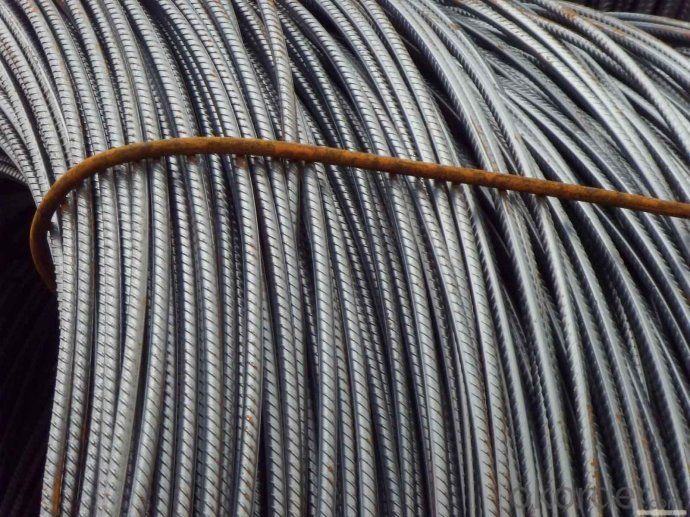
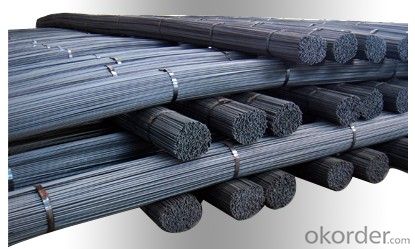
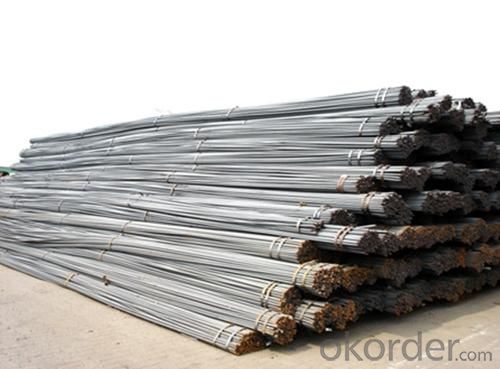
- Q:What is the process of straightening steel rebars?
- The process of straightening steel rebars involves several steps to ensure the rebars are properly aligned and free from any bends or deformities. Firstly, the rebars are carefully inspected for any visible defects such as twists, kinks, or bends. This initial inspection is important to determine the extent of straightening required and whether any rebars need to be replaced. Once the inspection is complete, the rebars are loaded onto a straightening machine. This machine consists of rotating rollers or hydraulic pressure devices that apply force to the rebars to straighten them. The rebars are fed through the rollers or placed between the hydraulic devices, and pressure is applied gradually to reshape the bars and remove any bends or twists. During the straightening process, it is crucial to maintain control over the applied force to prevent over-straightening or causing any further damage to the rebars. Skilled operators monitor the machine and adjust the pressure accordingly to ensure the rebars are straightened accurately. After the rebars have been straightened, they undergo a final inspection to verify that they meet the required specifications. This inspection includes checking for any remaining deformities, ensuring the rebars are of the correct length, and confirming that they are straight within acceptable tolerances. It is important to note that the straightening process can vary depending on the type and size of the rebars. Different machines and techniques may be used for larger or more complex rebars. Additionally, the process may involve heating the rebars prior to straightening to make them more malleable. Overall, the process of straightening steel rebars involves careful inspection, the use of specialized machinery, skilled operators, and a final inspection to ensure the rebars are straight, aligned, and ready for use in various construction projects.
- Q:How are steel rebars protected against extreme weather conditions?
- Steel rebars are protected against extreme weather conditions through various methods such as epoxy coating, galvanization, and concrete cover. These protective measures prevent corrosion and degradation of the rebars, ensuring their durability and strength even in harsh weather conditions.
- Q:Can steel rebars be used in railway and transportation infrastructure?
- Yes, steel rebars can be used in railway and transportation infrastructure. Steel rebars, also known as reinforcing bars, are commonly used in the construction industry to provide strength and support to concrete structures. In railway and transportation infrastructure, where robust and durable structures are required, steel rebars are often used to reinforce concrete elements such as bridge piers, abutments, and retaining walls. The use of steel rebars in railway and transportation infrastructure offers several advantages. Firstly, steel rebars enhance the tensile strength of concrete, making the structures more resistant to the dynamic and heavy loads imposed by trains and vehicles. This is particularly important in bridges and elevated structures where the loads can be significant. Secondly, steel rebars provide structural integrity and prevent the development of cracks and deformations in the concrete. This is crucial for maintaining the long-term stability and safety of the infrastructure, especially considering the constant exposure to various environmental conditions, such as temperature variations and vibrations. Furthermore, steel rebars are highly durable and resistant to corrosion, which is essential in railway and transportation infrastructure that is often exposed to harsh weather conditions and chemical agents. Their ability to withstand these factors ensures the longevity of the structures and reduces the need for frequent repairs and maintenance. In conclusion, steel rebars can and are commonly used in railway and transportation infrastructure due to their ability to enhance the strength, durability, and stability of concrete structures. Their use ensures the safe and reliable operation of these vital transportation systems, providing a solid foundation for the efficient movement of people and goods.
- Q:Can steel rebars be used in structures with high chloride ion concentration?
- Steel rebars should generally not be used in structures with high chloride ion concentration, as the presence of chloride ions can lead to corrosion of the steel. Chloride ions can penetrate the concrete and come into contact with the steel reinforcement, causing it to corrode and weaken over time. This corrosion can eventually lead to structural failure and compromise the safety and integrity of the structure. To mitigate the risk of corrosion in high chloride ion environments, alternative materials such as stainless steel rebars or fiber-reinforced polymers (FRP) can be used. Stainless steel rebars are more resistant to corrosion compared to regular steel rebars due to their higher chromium content. FRP rebars, on the other hand, are non-metallic and do not corrode, making them a suitable option for structures exposed to high chloride ion concentrations. It is important to consider the specific environment and exposure conditions when selecting the appropriate material for reinforcement in structures. Consulting with a structural engineer and following relevant building codes and standards can help ensure the use of suitable materials and prevent potential corrosion issues in high chloride ion environments.
- Q:What is the role of steel rebars in beam and column design?
- The role of steel rebars in beam and column design is crucial, as they serve to reinforce and enhance the structural integrity of these elements. In reinforced concrete structures, rebars are utilized to withstand tensile forces that concrete alone is unable to bear. When it comes to beams, it is common practice to position rebars at the bottom to counteract the tensile stresses caused by bending moments. By distributing the load along the length of the beam, rebars effectively bolster its strength and prevent the occurrence of cracks or failures. The tension-resisting ability of rebars is instrumental in maintaining the beam's shape and its capacity to bear loads, thereby ensuring the overall stability of the entire construction. Similarly, in columns, rebars are placed throughout their length to withstand both axial and bending forces. They enhance the column's capacity to endure compression, while simultaneously offering additional resistance against lateral loads from seismic or wind forces. The presence of rebars in columns significantly amplifies their load-bearing capability and overall stability. To summarize, steel rebars play a pivotal role in beam and column design by providing reinforcement against tensile forces, augmenting structural strength, averting cracks, and guaranteeing the overall stability and safety of the structure.
- Q:How are steel rebars protected from fire during construction?
- Steel rebars are typically protected from fire during construction through the application of fire-resistant coatings or by encasing them in fire-resistant materials, such as concrete. These protective measures help to prevent the steel rebars from reaching temperatures that could compromise their structural integrity in the event of a fire.
- Q:Can steel rebars be used in reinforced masonry?
- Yes, steel rebars can be used in reinforced masonry. Steel rebars are commonly used to enhance the strength and stability of masonry structures, such as walls or columns. The rebars are embedded within the masonry, providing added tensile strength and preventing cracking or failure under load.
- Q:How are steel rebars protected against damage from seismic events?
- Steel rebars are protected against damage from seismic events through several methods. One common approach is by designing the structure with reinforced concrete walls or columns that act as a shield, absorbing and distributing the seismic forces. Additionally, engineers can use various techniques such as providing adequate cover for the rebars, using epoxy-coated rebars, and employing seismic detailing measures like confinement reinforcement to enhance their resistance to seismic forces. These strategies collectively help to mitigate damage and ensure the structural integrity of the steel rebars during seismic events.
- Q:How do steel rebars affect the cost of a construction project?
- Steel rebars can significantly affect the cost of a construction project because they are a crucial component in reinforced concrete structures. The cost of steel rebars depends on their quantity, grade, and size, and it can greatly impact the overall project budget. Additionally, the transportation and installation costs associated with steel rebars should also be taken into account. Therefore, careful planning and consideration of the type and amount of steel rebars required are essential to manage and optimize the project's cost.
- Q:What are the factors to consider when choosing the right steel rebar for a project?
- When selecting the appropriate steel rebar for a project, several factors need to be taken into consideration. These factors include the type of project, the structural requirements, the environment, and the specific characteristics of the rebar. One of the key factors to consider is the type of project. Different projects, such as residential buildings, bridges, or highways, have varying structural requirements. The steel rebar selected should be able to withstand the anticipated loads and stresses of the project. Additionally, the size and shape of the rebar should also align with the project's design and specifications. Structural requirements play a vital role in choosing the right steel rebar. This includes considering the required tensile strength, yield strength, and elongation properties. It is crucial to select a rebar that can provide the necessary strength and durability to ensure the structural integrity of the project. The environment in which the project will be located is another significant factor. If the project is exposed to corrosive elements, such as saltwater or chemicals, it is important to choose a rebar with corrosion-resistant properties. This can prevent premature deterioration and maintain the longevity of the structure. Furthermore, the specific characteristics of the rebar need to be evaluated. This includes the grade of the steel, which determines its strength and ductility. Different grades, such as ASTM A615 or ASTM A706, have distinct properties that suit various applications. The surface finish of the rebar, such as plain or deformed, also affects its bonding ability with concrete. Other factors that should be taken into account include the availability and cost of the steel rebar. It is crucial to ensure that the selected rebar is readily available and can be obtained in the required quantities and sizes. Additionally, the cost of the rebar should align with the project's budget constraints. In conclusion, when choosing the right steel rebar for a project, it is essential to consider factors such as the type of project, structural requirements, environmental conditions, and specific characteristics of the rebar. By carefully considering these factors, one can select the most suitable steel rebar that ensures the durability and longevity of the structure.
1. Manufacturer Overview |
|
|---|---|
| Location | |
| Year Established | |
| Annual Output Value | |
| Main Markets | |
| Company Certifications | |
2. Manufacturer Certificates |
|
|---|---|
| a) Certification Name | |
| Range | |
| Reference | |
| Validity Period | |
3. Manufacturer Capability |
|
|---|---|
| a)Trade Capacity | |
| Nearest Port | |
| Export Percentage | |
| No.of Employees in Trade Department | |
| Language Spoken: | |
| b)Factory Information | |
| Factory Size: | |
| No. of Production Lines | |
| Contract Manufacturing | |
| Product Price Range | |
Send your message to us
ASTM GR60 deformed steel bar for construction
- Loading Port:
- Tianjin
- Payment Terms:
- TT or LC
- Min Order Qty:
- 25 m.t.
- Supply Capability:
- 100000 m.t./month
OKorder Service Pledge
OKorder Financial Service
Similar products
New products
Hot products
Related keywords
